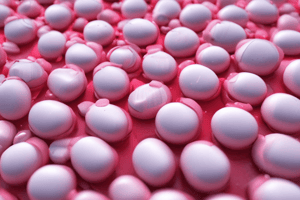Podcast
Questions and Answers
Which of the following is a characteristic of calcium channel blockers (CCBs) on cardiac muscle?
Which of the following is a characteristic of calcium channel blockers (CCBs) on cardiac muscle?
- Increase peripheral vascular resistance
- Decrease AV node conduction (correct)
- Increase SA node automaticity
- Increase cardiac contractility
Which type of calcium channel blockers (CCBs) may cause a baroreceptor-mediated tachycardia?
Which type of calcium channel blockers (CCBs) may cause a baroreceptor-mediated tachycardia?
- Neither dihydropyridines nor non-dihydropyridines
- Both dihydropyridines and non-dihydropyridines
- Non-dihydropyridines
- Dihydropyridines (correct)
Which type of smooth muscle is more sensitive to calcium channel blockers (CCBs)?
Which type of smooth muscle is more sensitive to calcium channel blockers (CCBs)?
- GI smooth muscle
- Bronchiolar smooth muscle
- Uterine smooth muscle
- Arterial smooth muscle (correct)
Which type of CCBs cause constipation and have many drug interactions?
Which type of CCBs cause constipation and have many drug interactions?
Which drug can cause Systemic Lupus Erythematosus (SLE)?
Which drug can cause Systemic Lupus Erythematosus (SLE)?
Which drug promotes hair growth?
Which drug promotes hair growth?
Which of the following is NOT a symptom of toxicity of Nitroprusside?
Which of the following is NOT a symptom of toxicity of Nitroprusside?
Which of the following is the correct onset and duration of action for Nitroglycerin spray?
Which of the following is the correct onset and duration of action for Nitroglycerin spray?
Which enzyme is most important for the activation of Nitroglycerin?
Which enzyme is most important for the activation of Nitroglycerin?
Which of the following is a potential mechanism for the development of tolerance to Nitroglycerin?
Which of the following is a potential mechanism for the development of tolerance to Nitroglycerin?
Which of the following is a characteristic of all oral calcium channel blockers (CCBs)?
Which of the following is a characteristic of all oral calcium channel blockers (CCBs)?
Which of the following adverse effects is associated with non-dihydropyridine CCBs?
Which of the following adverse effects is associated with non-dihydropyridine CCBs?
Which of the following drugs is a potent arteriolar vasodilator and often coadministered with beta-blockers to prevent reflex tachycardia?
Which of the following drugs is a potent arteriolar vasodilator and often coadministered with beta-blockers to prevent reflex tachycardia?
Which of the following is a common adverse effect of minoxidil?
Which of the following is a common adverse effect of minoxidil?
Which of the following is a characteristic of dihydropyridine calcium channel blockers (CCBs)?
Which of the following is a characteristic of dihydropyridine calcium channel blockers (CCBs)?
Which type of smooth muscle is more sensitive to calcium channel blockers (CCBs)?
Which type of smooth muscle is more sensitive to calcium channel blockers (CCBs)?
Which of the following is a characteristic of non-dihydropyridine calcium channel blockers (CCBs)?
Which of the following is a characteristic of non-dihydropyridine calcium channel blockers (CCBs)?
Which of the following calcium channel blockers (CCBs) causes peripheral edema and gastroesophageal reflux disease (GERD)?
Which of the following calcium channel blockers (CCBs) causes peripheral edema and gastroesophageal reflux disease (GERD)?
Which of the following drugs is associated with thiocyanate poisoning?
Which of the following drugs is associated with thiocyanate poisoning?
Which of the following calcium channel blockers (CCBs) is commonly coadministered with beta-blockers to prevent reflex tachycardia?
Which of the following calcium channel blockers (CCBs) is commonly coadministered with beta-blockers to prevent reflex tachycardia?
Which of the following calcium channel blockers (CCBs) is available in both oral and IV formulations?
Which of the following calcium channel blockers (CCBs) is available in both oral and IV formulations?
Which of the following adverse effects is associated with dihydropyridine CCBs?
Which of the following adverse effects is associated with dihydropyridine CCBs?
Which of the following drugs is a substrate and inhibitor of 3A4 enzyme?
Which of the following drugs is a substrate and inhibitor of 3A4 enzyme?
Which of the following drugs is a potent arteriolar vasodilator and may cause hypertrichosis?
Which of the following drugs is a potent arteriolar vasodilator and may cause hypertrichosis?
Which of the following drugs is a non-selective vasodilator that dilates both arterial and venous vessels?
Which of the following drugs is a non-selective vasodilator that dilates both arterial and venous vessels?
Which of the following drugs does NOT develop tolerance unlike nitroglycerin?
Which of the following drugs does NOT develop tolerance unlike nitroglycerin?
Which of the following drugs causes only a modest increase in heart rate with a net decrease in myocardial oxygen consumption?
Which of the following drugs causes only a modest increase in heart rate with a net decrease in myocardial oxygen consumption?
Which of the following enzymes is most important for the activation of nitroglycerin?
Which of the following enzymes is most important for the activation of nitroglycerin?
Which of the following drugs is commonly coadministered with beta-blockers to prevent reflex tachycardia?
Which of the following drugs is commonly coadministered with beta-blockers to prevent reflex tachycardia?
Which type of calcium channel blockers (CCBs) cause constipation and have many drug interactions?
Which type of calcium channel blockers (CCBs) cause constipation and have many drug interactions?
Which of the following drugs is a potent arteriolar vasodilator and may cause hypertrichosis?
Which of the following drugs is a potent arteriolar vasodilator and may cause hypertrichosis?
Which of the following is a characteristic of dihydropyridine calcium channel blockers (CCBs)?
Which of the following is a characteristic of dihydropyridine calcium channel blockers (CCBs)?
Which of the following calcium channel blockers (CCBs) causes peripheral edema and gastroesophageal reflux disease (GERD)?
Which of the following calcium channel blockers (CCBs) causes peripheral edema and gastroesophageal reflux disease (GERD)?
Which type of smooth muscle is more sensitive to calcium channel blockers (CCBs) than bronchiolar, GI, and uterine smooth muscle?
Which type of smooth muscle is more sensitive to calcium channel blockers (CCBs) than bronchiolar, GI, and uterine smooth muscle?
Which of the following drugs is a non-selective vasodilator that dilates both arterial and venous vessels?
Which of the following drugs is a non-selective vasodilator that dilates both arterial and venous vessels?
Which of the following drugs does NOT develop tolerance unlike nitroglycerin?
Which of the following drugs does NOT develop tolerance unlike nitroglycerin?
Which enzyme is most important for the activation of Nitroglycerin?
Which enzyme is most important for the activation of Nitroglycerin?
Which of the following adverse effects is associated with non-dihydropyridine CCBs?
Which of the following adverse effects is associated with non-dihydropyridine CCBs?
Which of the following drugs directly acts on the vasculature by releasing nitric oxide (NO)?
Which of the following drugs directly acts on the vasculature by releasing nitric oxide (NO)?
Which of the following calcium channel blockers (CCBs) is commonly coadministered with beta-blockers to prevent reflex tachycardia?
Which of the following calcium channel blockers (CCBs) is commonly coadministered with beta-blockers to prevent reflex tachycardia?
Which of the following drugs is a potent arteriolar vasodilator and may cause hypertrichosis?
Which of the following drugs is a potent arteriolar vasodilator and may cause hypertrichosis?
Which of the following adverse effects is associated with non-dihydropyridine calcium channel blockers (CCBs)?
Which of the following adverse effects is associated with non-dihydropyridine calcium channel blockers (CCBs)?
Flashcards are hidden until you start studying





